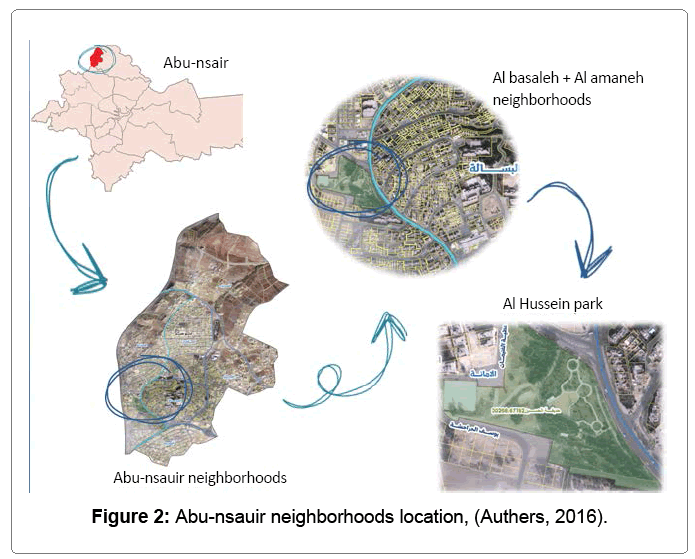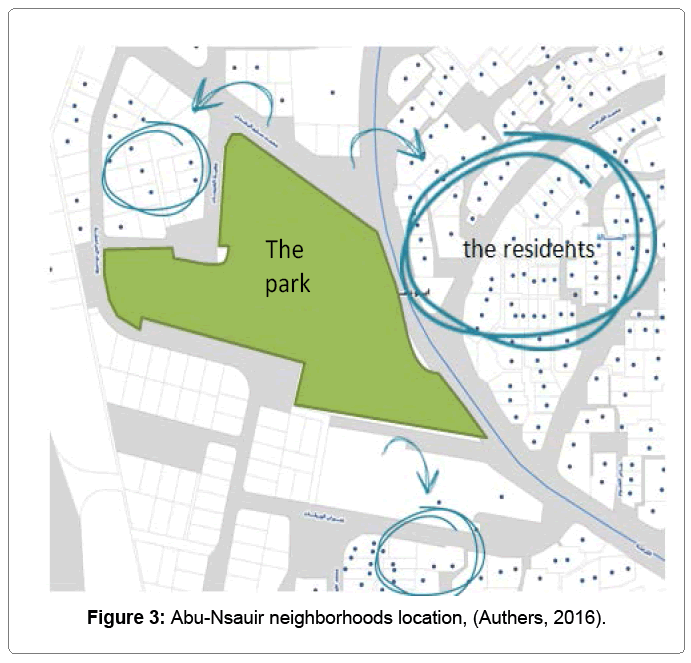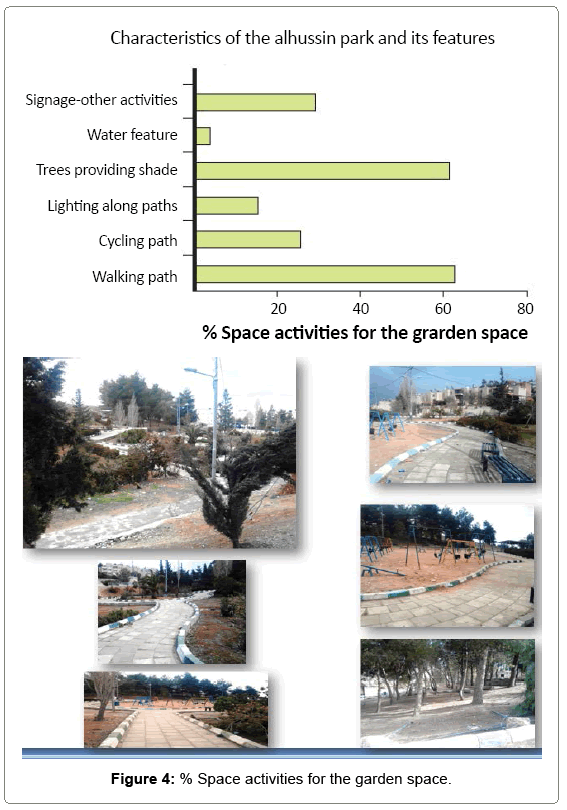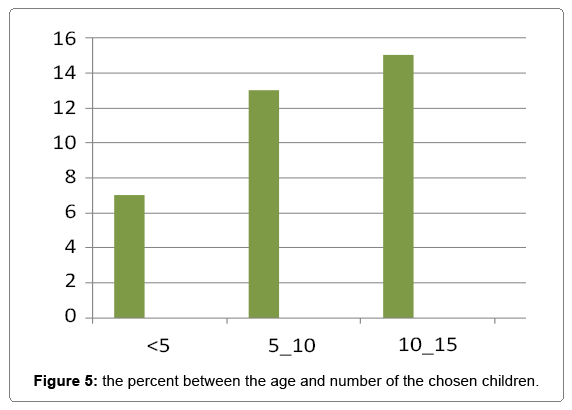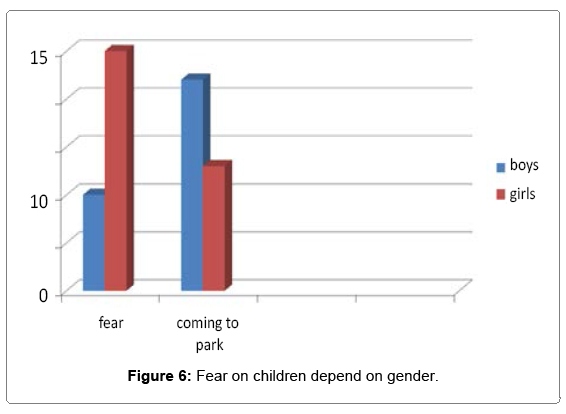Case Report Open Access
Relationship of Children Psychology and the Use of Public Parks: Case Study of Jbaiha Amman Jordan
Diala Atiyat*College of Engineering, Albalqaa Applied University, Kingdom of Jordan
- *Corresponding Author:
- Diala Atiyat
Lecturer at College of engineering
Albalqaa Applied University
Kingdom of Jordan
Tel: +962 777491180
E-mail: Archdiala@yahoo.com
Received date: August 20, 2016; Accepted date: October 19, 2016; Published date: November 01, 2016
Citation: Atiyat D (2016) Relationship of Children Psychology and the Use of Public Parks: Case Study of Jbaiha Amman Jordan. J Archit Eng Tech 5:173. doi: 10.4172/2168-9717.1000173
Copyright: © 2016 Atiyat D. This is an open-access article distributed under the terms of the Creative Commons Attribution License, which permits unrestricted use, distribution, and reproduction in any medium, provided the original author and source are credited.
Visit for more related articles at Journal of Architectural Engineering Technology
Abstract
The places which are considered child friendly exceed the reserved places for children such as parks and children’s corners. The children need to be given the approval to gain entry to their city with its various spaces, in addition to presenting the children with spaces that they can own and use freely. Achieving this is consequential, for it can play a major role in benefitting the child in all aspects, it can also give the child the opportunity to have the knowledge and understanding of what it means to be a mature and a respected part of the society. This article aims to highlight these aspects. It is imperative to allow the children in Amman city to spend time outside in the open air instead of spending time at home. The paper at hand will go through different approaches to get to the optimum child friendly environment by following strategies that ensure the establishment of cities that can be considered as child friendly, in addition to highlighting the importance of such approaches on the long run both on the society and on the children.
Keywords
Children psychology; Public parks
Introduction
Children especially in their early years spending most of their time at home inactively can contribute in causing issues to the child bodily and physiologically. The significance of the child’s health state has become one of the most acknowledged issues; in addition to the time the child spend outside and in open air.
Several issues can be observed after spending some time in Amman city, and that includes the parks that are not fit for the children to play in, the unsafe streets, lack of prepared areas that the children can use to play sports such as football which are located near the children’s houses, scarce means of transportation, in addition to unpreserved sidewalks. What children really need is the opportunity to investigate and inspect their surroundings, which can have an impact on their well being and affect their mental, psychological and societal growth. Thus, providing the children with spaces they can have, spend time in and be protected in is of great significance. It could be conclude through this study that for parks and open public areas to just exist do not particularly imply that they are attractive and suitable, overall both parks and open areas are either underutilized or depreciated. The proof and information encircling the linkage that connects children to parks and public open areas is slightly disordered up to now.
Objectives
This paper aims to study the children’s reciprocation with the local surroundings, and to explore the methods designers and architects follow to obtain direct and new data and facts the children provide regarding their requirements and usage of local open spaces. The paper will also accentuate on the role designers and architects play in producing public spaces that are considered child friendly and have a favorable impact on the growth of the children.
The paper at hand will view children who use public open spaces with the same perspective the adults are viewed, it will also address the issue of precluding children and youngsters from the proceedings of urban designing, and attempt to incorporate them in these procedures. The main issue is that children are never viewed as primary users of public open spaces; rather they are isolated in some closed spaces. It is advantageous to include children in the processes of urban design, for it will contribute in producing public spaces that draw the attention of children and their families, and encourage them to use these spaces that are secured and near their houses.
Methodology
The addressed inquiries and their explanations were analyzed via previous papers and researches that cover different disciplines; societal, methodical, medicinal and structural. The paper will also contain a case study that will be checked to ensure that urban planning has incorporated strategies to design a child friendly environment. A case study was selected, different accommodation plans were surveyed and examined in addition to a variety of implements that were utilized in the research, which includes inspecting the area, questionnaire, data and facts in addition to individual interviews.
The occupants’ observations and ideas regarding the issues included in the paper will be obtained by using questionnaires that contain an outline of the suggested open spaces.
Literature Review
Different papers will be analyzed that discuss several disciplines; medicinal, societal, methodical and structural. The influence of open spaces on the growth and improvement of children will be considered as well as determining the components responsible for separating children from the outside. This section will examine papers and articles focusing on societies and cities that are described as child friendly. Theses papers will include projects of world-wide corporations, and other projects that aimed to create child friendly spaces and settings.
Introduction
The thing that is missing in the city is actually an ingrained and fundamental flaw in the designing approach, and that is the lack of regard and perception of what is necessary for children, in addition to ignoring children’s ideas and observations concerning the spaces that are intended for them. When cities are designed to serve a handful of life’s aspects that make them slightly impractical and unrealizable. The city must be based on societal balance, hence, the opinions and observations of children, who are considered the frail and unprotected part of the community, ought to be previewed and comprehended side by side with the remaining parts of the community.
It is indispensible to allow children to express their opinions regarding their surroundings that they live in, get information from and spend time in. Children usually own what can be described as vigorous and energetic terminologies and expressions that they use to alter and attribute new purposes and objectives for the normal and ordinary items and matters. Such domain of figurative procedures and approaches must be properly examined and analyzed so that a child friendly space is actually created. It is a common knowledge that children live in their own universe, which makes it troublesome and hard for adults to compete with the intensity and fervor of the children’s creativity and imaginativeness. Taking this into consideration and attempting to implant it in the outlining approach will lead to accosting the corporeal architecture of the society’s design in addition to the characteristics that generate an unprompted help for the individuals. This is mainly attributed to the fact that children tend to utilize and comprehend their surroundings simply as an immediate result of their lifestyle and what they need.
Child psychology
In the attempt to interpret how children usually improve their perception of their environment, several techniques were approached, according to Sack (1980) there is a specific form of thinking he identified as ‘unsophisticated-fused’, which imply that hypothetical segregation of interval, matter, purpose and intellectuality cannot take place at exalted degrees of abstraction or in any case which depends basically on the concepts and theories of Inhelder and Piaget (1956; 1967) [1], among these concepts are inspections and views that describe the way the apprehension of the child and the resulting interaction with the child’s surroundings is subjected to change in time. Out of vertexes toward tracks and into the surroundings that encompass the tracks, and up to the theoretical linkage that connects the discontinuous vertexes and tracks, it is concluded that the child’s comprehension of spaces changes when the child grow up. The analysis of several noteworthy suppositions and presumptions focusing on the psychology and behaviorism of children led to confirm the concepts which explain that human beings’ existence is the evolution of their early years. Both the private and societal aspects and experiences of any person of age are dependent on how this person addressed and encountered his/her surroundings throughout childhood.
Piaget’s theory
In Piaget’s point of view, the primary issue regarding the growth and improvement of children is their source of understanding and comprehension. Piaget was fixed on the relationship that links the child to his surroundings, and he analyzed the manner with which knowledge, perceiving time, space and number are improved in a child. According to Piaget the child’s mental and psychological growth incorporate a certain progression of transformations in the psychological forms, improvements in the metaphorical design, in addition to recurrent and frequent rearrangement of the entire pattern of the forms. These forms are responsible for directing and regulating the child’s perception throughout different stages of age.
Piaget lay out a hypothesis dealing with the stages the child go through to acquire perception of space. Throughout the first phase, which occurs when the child is approximately 5 to 9 years old, the child starts to comprehend the so called ‘topological l’ relations; nearness, segregation, arrangement, surroundings and succession.
This phase of pre-operation suggests that it is possible that the child could be capable of effectually deliberating certain successions and arrangements; however, the child is not capable of inversing or speculating these conjectures significantly. The second phase occurs when the child is around 9 to 13 years old, during this phase the child is able to understand the proposed or projected space that can be analytical or illustrative in the circumstantial conditions, since the child at this age is capable to perceive and effectually perform amid successions of familiar connections and progressions of different challenges and circumstances.
At the age of 13, the ‘formal operational’ phase takes place, which is according to Piaget is the last and final phase. Throughout this phase the child is able to understand the meaning of Euclidean spaces in addition to being able to connect different spatial relations.
Freud’s theory
Freud made the assumption that a child’s development happens in a set of fixed biological and anatomical phases, and is formed through fundamental basic causes or compulsions. And the child’s approach to deal with different encounters and challenges throughout these phases will have a major impact on his life as an adult. (Freud, 1989). Both Piaget and Werner observed a distributed arrangement of attainable systems visible in infants, which on his first interaction with his surroundings begin his growth into maturity [2].
Werner’s theory
Werner accentuated on the independency of the various prospects of the human demeanor, he also stressed on the relationship that links the human conduct with the entire circumstantial setting as to where it takes place, and that is comparable to Piaget’s ideas. Throughout his work, Piaget focused on the maturing and development of a singular being, however, Werner focused on improving a hypothesis that influences the entire experimental approaches; cultural, biological and societal. According to Werner the improvement occurs in a similar manner and via similar phases, even though the outer circumstances may vary [3].
Kurt Lewin’s theory
Lewin mainly considered the connection that the children and their environment share as a vigorous and active reciprocation of compulsions and motives. The models of human conduct are basically the result of the fraction and strain that occur between the child and his surroundings. (Lewin, 1936).
What do urban children need from their physical environments?
It is essential to comprehend the way urban and public settings influence children and their requirements to be able to construct and direct cities which function for the sake of children. The children require protection, balance and safety that the appropriate accommodations offer, it is essential for them to live in wholesome and secure settings. The children must be given the opportunity to have fun and enjoy their time, and they must be presented with psychological and societal improvement offered by the various, invigorating and available districts and neighborhoods. However, the conflict facing provincial jurisdiction and their associates is to thoroughly contemplate and consider their endeavors concerning the public health, improving accommodations, streets structure, property ownership administration et cetera, in addition to the way these endeavors may advance in case they were performed to produce favorable results for the children [4].
Such fatalities are mostly caused by illnesses that can be avoided and averted [5]. Children are considered to be influenced to a greater level than grownups due to the following: the children’s immune system is not developed and efficient as the adults’ immune system, thus, they are not able to deal with the different types of bacteria and viruses existing in their environment, children have the propensity to be vulnerable more than adults to pathogens, particularly infants because they spend a lot of their time on the ground when they start crawling and they tend to put different objects in their mouths. Generally, older children do not understand and value the importance of being hygienic and clean, in addition they tend to play and spend time without thinking of the consequences.
The neighborhoods must be prepared in a way that allow children to live away from harm’s way and from grave danger, which includes intoxication, burns, car accidents and falls. Car accidents are accountable for a great rate of injuries and deaths amongst
Children and the city in the Middle East
The child across the Middle East is viewed as a critical and vital linkage that connects generations. Up to a short time ago, concepts such as matrimony, raising children as well as childhood were built on certain established beliefs and suppositions connected to the community with its diverse age groups. The Middle East with its paternal communities is known for cherishing and treasuring children especially the males. The children are then prepared and fitted by their ‘gender role’ which leads to a separation of the type of work and activity assigned to them at a young age. Yet, there still remains a small proof of the significance of having a cheerful and a happy childhood or a childhood in general as a fundamental phase in life [6].
Certain districts and cities in the Middle East and North Africa or MENA domain have demonstrated an exceptional and unmatched development in the numbers of population, which greatly influenced the most unprotected and weak category in the community and that is children. In 2003 the population numbers ranged about 400 million, and among these were more than 50% children and youngsters under 18 years old. Above 60% of these children and youngsters are currently living in MENA’s different cities and districts, and that will subject them to a variety of challenges and give them a lot of chances and possibilities that might be of help in their attempt for bettering the lives of future generations. It is essential to assure that children are being raised so that they become wholesome, creative and effectual grownups, since children are the hope for a better future [7] (Figure 1).
The conditions of children in Amman
Considering the following illustration of ‘population pyramid in Jordan’, 40% of the entire Jordanian population is under 15 years old, and approximately 66.6% of the population is under 25 years old. Throughout the following 15 years, those children and teenagers will be of age to have children of their own and to be a part of business and employment. The growth in the numbers of subordinate or dependent public, results in a substantial transformation socially and demographically, these transformations incorporate a decrease in birth rates, increment in the rural-urban migration and emigration, in addition to modifying the ‘gender roles’ in the community, which influence the extent of the household and preferring a principal arrangement of the domestic structure. However, the family’s significance and value was not affected or lowered, neither the family’s part in keeping its members secure and protected and taking care of and assisting all the members young and old [8].
Abu-Nsuir Jordan: It is located in the north-west of Amman, it extends over 6 square kilometers (6.74 KM) and has an estimated population of more than 70,000 according to Department of Statistics (2004), the city has many schools and parks and it is divided to 6 neighborhoods, the houses are mostly 3-4 stories with red blocks.
Local case study selection: Housing schemes are integrated neighborhoods unlike residential area which were built on different stages and provided with services and open spaces later.
Abu-Nsuir was chosen as a study case in this research because it is considered an excellent example for housing schemes. (The area of Abu Nsuir advantage of the organization and a unique arrangement between the Amman areas, it built and organized special provisions and areas that were previously the organization assesses citizen analgesic that it is inflicted not by pointing out that the organization of the region Ultimate level of cleanliness and vast green spaces (Beltagy 2013)
Another reason for chosen Abu- Nsuir that it is a residential area contains many families and children can be useful in the research study.
the area is located in location between (alamaneh + albasaleh) neighborhoods, somewhere around Al Husain Park (Figure 2).
For the purposes of this study, the public open space was chosen is alhussain park it is located between the resident houses and it is considered the largest park in abu nsuir.
Al Hussian park: A triangle shape park which covers 30000 m2 approximately, the park is fenced from all the side, it is accessible from 3 points, Alhussain park has several facilities, and it is considered the largest park in abu nsuir neighborhoods, the park is used by almost all age groups, and its main users are neighborhoods residents. Sometimes families from outside the neighborhoods visit it in the weekends with their children (Figure 3).
Parents in the Abu Nsaer Amman viewed outdoor play as an integral part of the health and development of their children. However, recent trends have diminished children’s outdoor play opportunities. These trends included children’s play spaces moving from outdoors to indoors, less autonomy for children outdoors, and children being taken by car across longer distances to reach isolated play spaces rather than walking a smaller network of linked play spaces.
Outdoor play areas are important for children because they provide a place to meet and interact with their peers. Outdoor play can lead to a network of social and emotional support for parents, because as children get to know one another, so do their parents. Immigrant parents saw outdoor play as an opportunity for their children to acculturate.
Urban communities created play spaces at the street level in a variety of ways (e.g. converted a street to a large grassy strip, created pathways within gardens that allowed children to safely move from one garden to another, blocked off streets from car traffic) (Figure 4).
Questionnaire Procedures
The questionnaire and interviews were designed keeping in mind these theories spatiality Walsh (2006) theory “differences between age groups in relation to the need of children with in play spaces “and theories about child psychology, as at all times I had to maintain the interest of the child to get maximum response and output from them. I had to keep them involved. To do that, it was crucial to know how they think. According to Piaget, the child derives stimuli from the environment, but for it to derive stimuli it needs to have some constant connection when his environment, which is lacking nowadays. I made conscious efforts to receive these lost connections. They had to start appreciating and become aware of their environment before they could make any connections. That was what the study was going to be about: to become “aware”. Piaget also theorized that between the ages of 9 and 13, the child starts understanding and recognizing relationships within the physical world. That is why I chose to work with that age group. According to Werner these connections are the root for most developmental processes. As Lewin believed, it’s a reciprocating twoway connection where each gains from other. The created connections were sources of self-reflection for these children, which lead to concerns at a more personal level.
The reason that I chose to work with the age group 11-13 was, as Freud believes, that the way a child handles experiences and conflicts during his childhood reflected later and affects them when they mature. These children were the future of the society and their decisions would be important in some years. Conscious community efforts at this early stage in life may become a potential resource in their later years.
The questionnaire was directed to families living in this neighborhood and their children.
The children whom had been picked to answer the questionnaire and interviewed are familiar with this area, and could identify their wishes and needs more specifically.
The children were asked to dream about their neighborhoods and state their wishes. They mostly mentioned that they wanted a safe place with flowers, trees, and a large football field where they can play. A quite place away from traffic was a wish that was encountered frequently. The children also mentioned that they wished the, houses and the environment would be kept clean, and that no trash would be thrown around.
After the “My Dreams and Wishes List”, the children were asked about the things they love and hate the most in their neighborhood.. The things that the children loved in their neighborhoods were the greenery, park, flowers, and trees.. Moreover, the children mentioned having many people around, and the social relationships between the kids and their families in the neighbor, and the closeness of people to one another.
Only households with children under the age of 15 were asked to answer the questionnaire. 21 families were picked with their children 29 adults + 35 child and another 16 children were interviewed alone.
Study findings
In the survey, most of parents who answered the adult questionnaire were female (Table 1).
| Female | 21 | 72% |
| Male | 8 | 28% |
| Total | 29 | 100% |
Table 1: Distribution of respondents in the neighbourhood by gender.
Characteristics of study participants the survey was completed by parents of 35 younger children and adolescents, Younger children were approximately 8 years old, and older children/adolescents were approximately 15 years old at the time the survey was completed (Figure 5).
The parents implied that they have private outdoor space attached to their houses the most of them lives in apartment attached with balcony and few of them lives in independent house with front\back yard (Table 2).
| Front\ back yard | 5 | 25% |
| Balcony | 14 | 66% |
| Roof | 2 | 9% |
| Don’t have | 0 | 0% |
| Total | 21 | 100% |
Table 2: Distribution of respondents in the neighbourhood according to having private outdoor space attached to the house.
Response for the attached outdoor spaces wither is it enough for playing or not, was 22% said yes 88% said no.
Children play inside the house is affected by the availably of private outdoor Spaces in their houses but it were found that children in the neighborhood are playing a lot of time inside their houses and the number is increasing for the female child.
Allowing girls to play outside is effected by parental fear; parents don’t allow their daughters to play outside due to stranger fear. About feeling safe boys feel safe in coming to park alone more than girls (Figure 6).
Alhlusain Park – abu Nsuir located in an excellent location where many potential users exist. At present however it fails to provide an environment that encourages users to visit and stay in the space (Table 3).
| Indoor | 29 | 56% |
| Outdoor | 22 | 44% |
| Total | 51 | 100% |
Table 3: Respondents in the neighbourhood for children who prefers indoor, outdoor activities.
According to the results of interviews with parents and children groups, it was found that fears over abduction and busy roads mean that parents would rather their children took part in indoor, supervised activities. However, that would encourage children to have more 'screen time' in front of televisions or computers and video games instead of going outside and play. That will effect on provides children with 'key for life skills'.
Safe, fun environments that allow children to play together give children the opportunity to learn how to socialize as well as enjoy themselves.
Conclusions
This paper aims to outline the deficiency of proof and information regarding the role of public open areas and areas in both the children and adolescents’ wholesomeness and health. Parks and public open areas’ accessibility and usage can be advantageous to the bodily, societal and psychological wellbeing of children. Having appropriate parks is exceedingly crucial especially for present-day children and youngsters, because they are raised in environments with organized and controlled ‘play’, gardens with small areas, increasing degrees of inactive and passive conduct in addition to children’s overweight and dejection. Nevertheless, for parks and open public areas to just exist do not particularly imply that they are attractive and suitable, overall both parks and open areas are either underutilized or depreciated. The proof and information encircling the linkage that connects children to parks and public open areas is slightly disordered up to now. The paper at hand aimed to unite and combine the accessible and obtainable information. Besides, there exist different departments, organizations, public assemblies, analysts and plan designers who view this problem as a relevant problem, and that incorporates various individuals with occupations and professions not related to either children or youngsters, yet they influence both the natural and constructed settings.
In some cases the nearest public open area is not considered the most exciting and attractive area in the girls’ standpoint. According to the outcomes of a planning and designing survey conducted in Abu- Nsuir targeting children, it was concluded that fundamentally the children’s choice of the park where they play and spend time was not the park near their homes, usually the children chose the park that is situated as far as double the distance compared to the nearest park or play area.
References
- Barbel PJ (1967) The childâÂ?Â?s conception of space. WW Norton, Newyork.
- Morris J, Wang F, Lotta L (2001) School ChildrenâÂ?Â?s Travel Patterns A Look Back and a Way Forward. Transport Engineering in Australia 7: 15-25.
- Veitch J, Bagley S, Ball K, Salmon J (2006) where do children usually play? A qualitative study of parents' perceptions of influences on children's active free-play.
- UNICEF (2004) Building Child Friendly Cities: A Framework for Action. Florence: UNICEF.
- UNICEF (2007) Child poverty in perspective: An overview of child well-being in rich countries. Florence: UNICEF.
- Children and the city conference (2002) Municipality of great Amman.
- Susan H, Cao X, Mokhtarian P (2008) Neighborhood Design and ChildrenâÂ?Â?s Outdoor Play Evidence from Northern California. Children, Youth and Environments 18: 160-179.
- Fernea EW (1995) Children in the Muslim Middle East. Cairo American University of Cairo Press.
Relevant Topics
- Architect
- Architectural Drawing
- Architectural Engineering
- Building design
- Building Information Modeling (BIM)
- Concrete
- Construction
- Construction Engineering
- Construction Estimating Software
- Engineering Drawing
- Fabric Formwork
- Interior Design
- Interior Designing
- Landscape Architecture
- Smart Buildings
- Sociology of Architecture
- Structural Analysis
- Sustainable Design
- Urban Design
- Urban Planner
Recommended Journals
Article Tools
Article Usage
- Total views: 4228
- [From(publication date):
December-2016 - Jul 09, 2025] - Breakdown by view type
- HTML page views : 3285
- PDF downloads : 943


